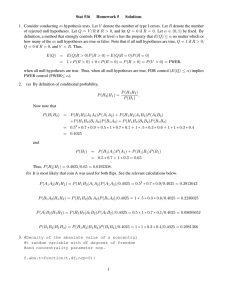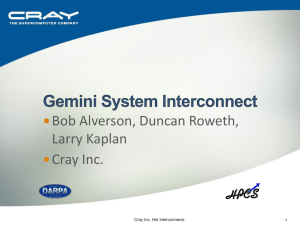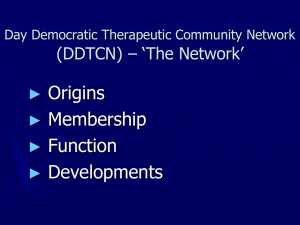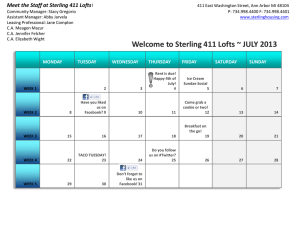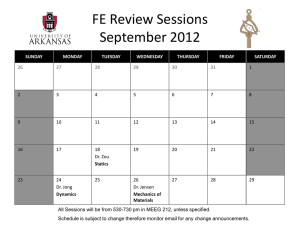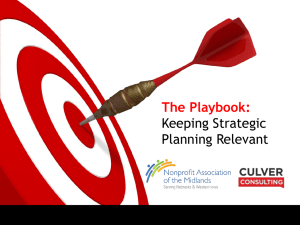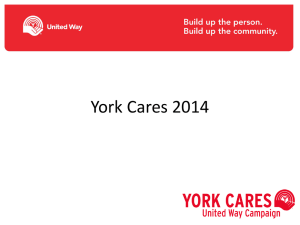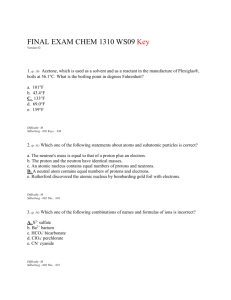Powerpoint Slides - Department of Community and Family Medicine
advertisement
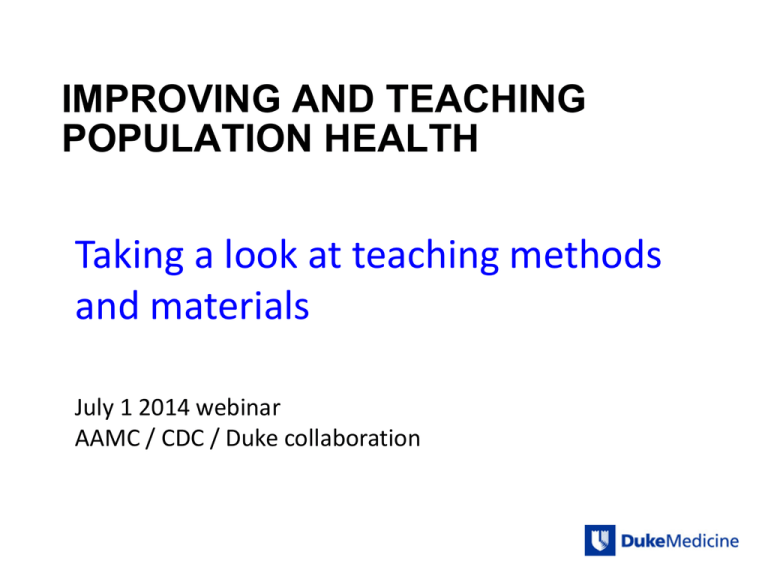
IMPROVING AND TEACHING POPULATION HEALTH Taking a look at teaching methods and materials July 1 2014 webinar AAMC / CDC / Duke collaboration Mina Silberberg, Ph.D. Associate Professor Vice-Chief for Research and Evaluation Division of Community Health J. Lloyd Michener, MD Professor and Chair Department of Community and Family Medicine Director, Duke Center for Community Research Gwen Murphy, RD, MS, PhD Assistant Consulting Professor Division of Community Health Department of Community and Family Medicine Population Health: the health outcomes of a group of individuals, including the distribution of such outcomes within the group. Source: Kindig D, Stoddart G. What is Population Health? Am J of Public Health. 2003; 93(3): 380-383. The Goal: “from Health Care to Health” How do we teach clinicians to collaborate in population health improvement? • not training clinicians to be public health professionals, but to collaborate with public health and other sectors from their unique vantage point and strengths • sometimes clinicians will take the lead, but not always Focus today: Sample training materials and methods • • • • Population Health Competency Map Practical Playbook iCollaborative Population Health Collection Duke Family Medicine PHIT curriculum The Population Health Competency Map Kaprielian VS et al. A Competency Map Approach to Education for Population Health. Academic Medicine 2013 8(5): 628-637. PMID: 23524919. The Population Health Competency Map Training Levels: 1. Foundational — Basic awareness of the principles and appreciation for their impact and importance in community health. 2. Applied — An intermediate level of learning, enabling skilled participation in community-engaged population health activities. 3. Proficient — Advanced learners who achieve competence for independent practice or leadership of the design and implementation of community-engaged health improvement activities. Competencies • • • • Public Health Community Engagement Critical Thinking Team Skills Population Health Curriculum, sample competency: Training levels Basic Intermediate Advanced Learner types • • Primary care residents CFM faculty • Identify appropriate preventive strategies for a population, based upon literature, data assessment and stakeholder input All students & residents • Competency • Discuss potential population-based interventions to improve health • • Population health fellows & faculty CH faculty Develop and implement population-based prevention strategies in collaboration with community partners The Practical Playbook for the Integration of Public Health and Primary Care www.practicalplaybook.org What is integration? The Institute of Medicine defines integration as ‘the linkage of programs and activities to promote overall efficiency and effectiveness and to achieve gains in population health.’ Principles of Integration: Shared goal of population health Aligned leadership Community engagement Sustainability Collaborative use of data What is the Practical Playbook? Practical guidance to support the application of integration principles to practice Practical Playbook Overview 3. Share The AAMC MedEdPORTAL iCollaborative https://www.mededportal.org/icollaborative/ https://www.mededportal.org/icollaborative/about/initiatives/populationhealth/ Population Health Improvement Teamwork (PHIT) An evolving curriculum of Duke Family Medicine For residents (4/year) And faculty Domain Population HealthNon-Specific, i.e., covers multiple domains PHIT Year 1 (PGY1) Introduction to Pop. Health. Lead: Michener PHIT Year 2 (PGY2) Population Health Core Course (2nd, 4th, and 5th Tuesdays). Lead: Silberberg. Pop. Health Workshop. Lead: Martinez-Bianchi PHIT Year 3 (PGY3) Advanced Population Health (12 sessions (1/month)). Lead: Murphy Facilitation of one core course discussion session. Lead: Silberberg A Real-Life QI Experience. Lead: Hull All three years: Population Health Workshop with Residency Applicants. Lead: Martinez-Bianchi. Population Health Management Rotation (includes community health rotation with informatics component). Lead: Shahsahebi Attend Partnership for a Healthy Durham meetings. Lead: Martinez-Bianchi Balint Group. Lead: Kingsolver. Population Health Projects. Leads: Silberberg and Shahsahebi Presentation: The Durham Community Health Needs Assessment (Erika Samoff). Lead: Silberberg Domain PHIT Year 1 (PGY1) Population Public Health Health Domain I: Essential Public Health Function webbased modules with one followup discussion. Lead: Murphy PHIT Year 2 (PGY2) Population Health Domain II: Community Engagement Community health assessment Rotation in community and presentation. Lead: Tran. clinic. Lead: MartinezBianchi Leading a community health education session. Lead: Tran Site visits (e.g., CAARE, Lincoln, Public Health Dept.). Lead: Tran PHIT Year 3 (PGY3) Attending a PAC meeting. Lead: Ragsdale Rotation in community clinic. Lead: Martinez-Bianchi All three years: Community Health Engagement Day. Lead: Martinez-Bianchi Sometime over the three years: Involvement with community health education training. Lead: Martinez-Bianchi Domain Population Health Domain III: Critical Thinking PHIT Year 1 (PGY1) (See RCD below) PHIT Year 2 (PGY2) PHIT Year 3 (PGY3) I-3 Quality Thread Webinar. Lead: Ramer I-3 Quality Thread Webinar. Lead: Ramer All three years: Journal club. Lead: Ostbye Population Health Domain IV: Leadership/Team Skills (Lead: Ragsdale) Resident as Clinical Director I -- quality improvement and informatics, assessment of leadership skills/training plan, time management, professionalism. Lead: Ragsdale Resident as Clinic Director II -team development /group facilitation, organizational behavior and culture, collaboration in large systems, health policy. Lead: Ragsdale. Resident as Clinic Director III -- assessment of remaining leadership training needs and corresponding plan, business of medicine. Lead: Ragsdale All three years: Workshops on leadership, communications, and conflict management. Lead: Kingsolver Resident Population Health Project Requirements During the course of the three years, the resident must: 1. Play a lead role in at least one effort that involves two or more rapid CQI 2. Design an evaluation plan, collect data, analyze data, or write up evaluation results. 3. Collaborate with non-clinical entities on a community health initiative. Additional requirements 1. Document and disseminate 2. Use appropriate tools 3. Formal mentor 4. Approved workplan Population Health Curriculum evaluation methods • • • • • Discussion participation Project completion Final assessment – just alpha-tested Post-graduation activity Real test – health improvement in home communities Recent/ongoing developments • PHIT, not PHIL • Inclusion of population health management rotation • Changes to project to enhance community engagement, alignment with ongoing work of clinic • Testing and revising of final assessment • Development of alumnae survey questions’ • Increased integration among PHIT components and between PHIT, larger curriculum, and clinical practice Milestones webinar schedule repeated June 3rd Tuesday 2:30pm EST June 19th Thursday 3:30pm EST repeated July 1st Tuesday 10am EST July 15th Tuesday 9am EST repeated August 5th Tuesday 9am EST August 12th Tuesday 9am EST repeated September 9th Tuesday 10am EST September 16th Tuesday 3pm EST repeated October 8th Wednesday 3pm EST October 14th Tuesday 9am EST Next Steps • Anybody willing to volunteer today to make an institutional presentation? • Sharing of alumnae survey questions and other evaluation tools…
